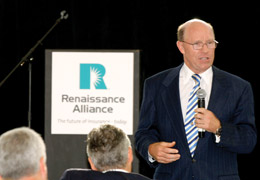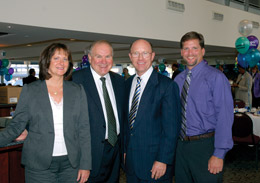|
Marketing
A great revival
Renaissance Alliance helps independent agents grow, prosper and stay independent
By Dennis H. Pillsbury
Dictionary.com defines renaissance as “the activity, spirit, or time of the great revival of art, literature, and learning….” J. Bruce Cochrane had that in mind when he founded the Renaissance Alliance to help agencies “get to the next level,” while still maintaining their independence.
Bruce got the idea for Renaissance Alliance when he started working in 1976 at his father’s small agency in Boston. Most of his time was spent on paperwork and administrative functions in addition to putting out fires and finding markets that would take the business he managed to sell, leaving him little time to do what was needed—sell.
Many agencies don’t have the wherewithal to hire a person for each function. What is needed is a jack-of-all-trades who can take over any position from the agency owner. However, few individuals have the diverse talents needed to handle all the functions required to have a smoothly running insurance agency. But, Bruce thought, a separate entity could hire a number of individuals with those talents and make them available to independent agents that wanted to get out from under marketing and administrative chores. Such a group could bring economies of scale to bear and could also provide marketing advantages by having a volume of business that would be of interest to insurance companies.
So, about five years ago, he started the Renaissance Alliance in Wellesley, Massachusetts, to provide marketing and administrative services, as well as market clout, to independent agencies located in the area. He was able to attract investors to the venture partly because it was a good idea and partly because he already had a track record, having successfully started the workers comp captive, Minuteman Insurance Co., Ltd.
Bruce envisioned Renaissance being much like its namesake--constantly changing and adding new services so its members could compete and prosper in an ever-changing risk transfer marketplace. The core idea was to enhance the strengths of the independent agency system--two of the most important being local representation and a variety of markets. “We would provide the leverage of a large organization so our members would be able to continue to provide local service to the community,” Bruce says. “They had the trust of their insureds, and we had the markets and administrative backup.”
Today, the Renaissance Alliance has 52 partner agencies operating out of 67 locations in Massachusetts, Connecticut and Rhode Island. Premium volume totaled $289.9 million as of September 30, 2006, with $151.9 million coming from personal lines and $138.0 million from commercial lines. Personal lines volume grew 13.1% from a year earlier, while commercial lines showed a 37.4% growth. And this has been achieved without sacrificing underwriting integrity. The three-year average loss ratio in the personal lines is 48.7% and in commercial lines, it is 33.6%.
Bruce, who serves as president and CEO of Renaissance Alliance, points out that the strong loss ratio performance has been “a key factor in proving the efficacy of our aggregation strategy. Our profit-sharing revenue for 2005 business totaled a little over $5.2 million, representing 4.4% of earned premium. Our member agencies are realizing profit-sharing returns of two to four times what they would have received as stand-alone agencies.”
The success of Renaissance Alliance in reaching appropriate markets is shown by the fact that it has bound 59.5% of the commercial lines submissions sent to it by partner agencies. The Alliance received 6,955 submissions and quoted on 6,181 of them. Subsequently, 3,677 were bound. Of the 4,203 new business submissions, Renaissance quoted on 3,729 of them and 1,977, or 53%, were bound. “Hit ratios of 50% of better represent huge success in terms of both the skill of our producers and the efficacy of our marketing and placing capabilities,” Bruce notes.
Becoming a knowledge broker
While the results are impressive, “we cannot afford to rest on our laurels,” Bruce says. “We recognize that growth requires change, and to have meaningful change, we must be innovative. The services that we provide today include processes that are vital to the successful operation of an independent agency, but far more important to future success is knowledge. While we will continue to enhance those processes (one example being the migration to AMS 360 that will occur over the next two years), we are emphasizing the delivery of knowledge, expertise and differentiation.
“The result of this emphasis will be to deliver on the only meaningful point of differentiation—value. The delivery of meaningful and lasting value will be the single greatest element that will distinguish Renaissance Alliance and our partner agencies far above all other insurance delivery mechanisms,” Bruce maintains.
“Renaissance Alliance is and always will be a work in progress. We will continue to evolve based on the needs of our agencies, which will evolve going forward in ways we cannot foresee right now.”
Bruce continues, “Renaissance Alliance has to continually push the envelope to the edges of possibility. We have to build on each success and learn from each setback.”
Innovative thinking
“One of the key changes in the agency business is the nature and knowledge of our clients,” he adds. “We are no longer in the insurance business, we are in the risk transfer business. Our carrier partners are extremely important. They will always provide the risk transfer solutions for the majority of our agency partners’ clients. However, we also need to consider the alternative market for some of our clients.
“Renaissance Alliance members have access to Minuteman for workers comp when appropriate, but there are other areas that we need to explore as we move into additional specialty niche markets. Our goal is to create multiple proprietary specialty programs, in which each qualifying risk has a predetermined, most-appropriate carrier at the market price. In some instances, the most appropriate carrier may not be a traditional insurer.
“Our partner agencies have a goal to provide the most appropriate risk transfer solution to each of their clients at a price that is commensurate with the underlying risk and in an acceptable time frame,” Bruce says.
“Our clients are becoming more sophisticated and we have to respond by increasing the knowledge base of our partner agencies,” he continues. “And we see this as an opportunity where we can provide our agents with innovative risk transfer solutions that they can bring to their clients.
“The winners in our industry will not be those with the lowest price, the most markets, the flashiest IT systems, or the slickest proposals,” he concludes. “The winners will be those to deliver the greatest value. Value in today’s perspective can best be measured in terms of knowledge, expertise and specialization. In turn, value establishes a lasting differentiation that turns clients into partners and agents into trusted advisors.” *
For more information:
Renaissance Insurance Group
Web site: www.renaissanceins.com
Contact: Lisa Johnson (800) 514-2667 |
|
Click on image for enlargement |
 |
| |
J. Bruce Cochrane, President and CEO, Renaissance Insurance Group,
addresses the Third Annual Renaissance Alliance Team Meeting at Gillette Stadium in Foxboro, Massachusetts. |
| |
 |
| |
Janet Cochrane, Chief Operating Officer of the Renaissance Group (far left) and Bruce joined two of the conference speakers: Gerald W. Faust, Ph.D., Founder, Faust Management Corporation (second from left) and Stephen Faust, Senior Consultant, Faust Management Corporation. |
| |
 |
| |
The Renaissance Alliance Team Meeting brought together agency partners, insurance company representatives and vendors to network and prepare for the future. |
|


